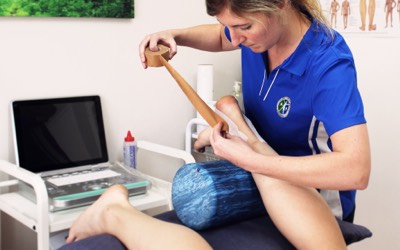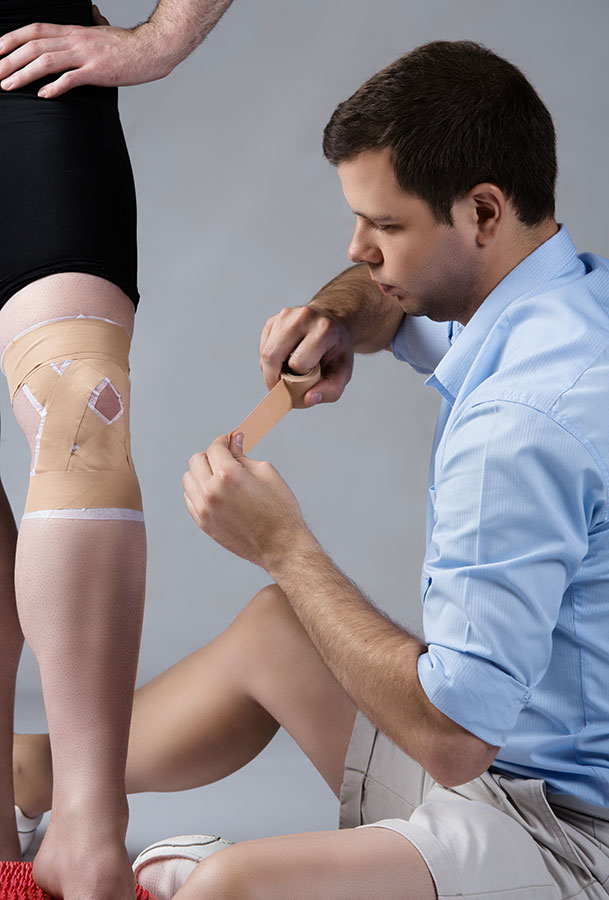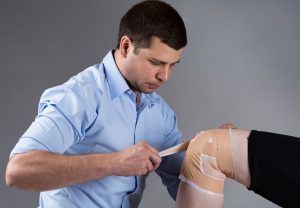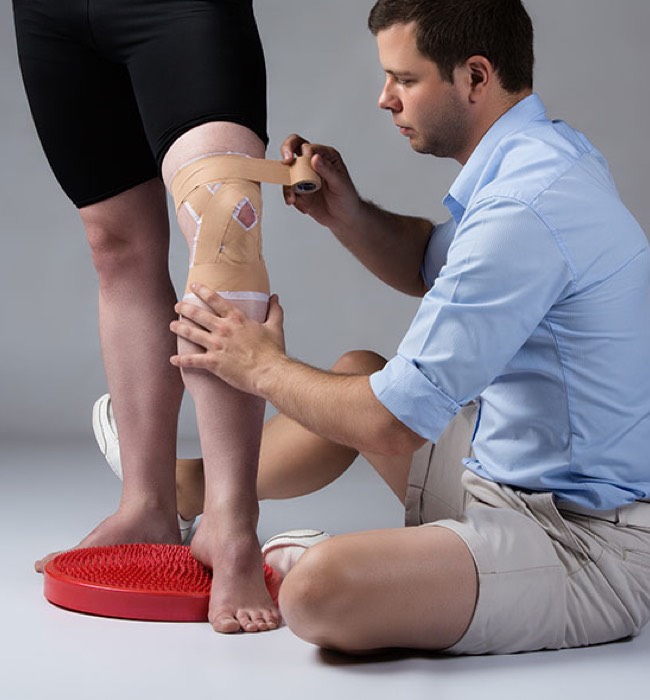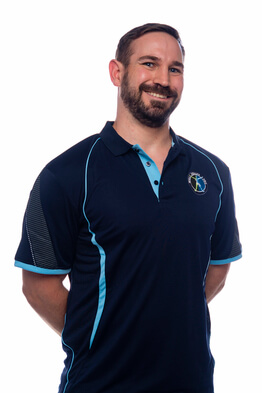If you’ve ever watched any form of sport or read a sports article, chances are that you’ve seen rigid strapping in some shape or form. And if you participated in sports you probably even have first hand experience of strapping. While it isn’t as popular as the colorful kinesiology taping methods, rigid taping is an extremely useful tool when we treat sports injuries and orthopedic conditions. In acute injuries, like ankle sprains or MCL tears, where protection and stability are needed, rigid taping is the way to go.
What exactly is rigid strapping?
There are different techniques we use rigid tape for, usually depending on the goal of treatment. What they all have in common, though, is the kind of tape used. Rigid tape is exactly what the name implies: tape that doesn’t stretch. Even though there are different kinds of rigid tape that vary in stiffness, they all need to provide stability by resisting movement.
Why we use rigid strapping
Rigid taping hasn’t been in the spotlight much over the last couple of years due to the popularity of more elastic kinds of tape, like kinesiology and dynamic tape. Although the newer strapping techniques are also useful, rigid strapping definitely has its own place in pain management and rehabilitation.
To explain why we use rigid strapping, we have to take a quick detour to what we want when we apply it. As the name implies, rigid strapping doesn’t move. Therefore, it also doesn’t allow movement when applied. In practice, we use this feature of rigid tape to immobilize, protect and stabilize an injured joint. As a consequence, we unload painful, injured structures, with a happy extra benefit of pain relief. Less pain means better movement, muscle activation and decreased swelling. All these factors encourage and promote your body’s normal healing response.
Benefits of rigid strapping
- Manage pain
- Decrease swelling
- Reduce tension on muscle tears
- Muscle activation
- Enhance proprioception
- Stabilize injured or painful joints
- Immobilize ligament injuries
“There’s no such thing as magic tape – it’s all about knowing when and how to apply it.”
The Technique
When we apply rigid strapping, you always have to start with a diagnosis. Physiotherapists are trained to assess your injury, thereby making a clinical diagnosis. Applying strapping without knowing what’s wrong is like hiding a wound under a bandage. What looks like a scratch could actually be a thorn or broken bone. We also need a diagnosis to determine the correct type of strapping and which technique we need to use.
If strapping is appropriate for your diagnosis, we will start by cleaning the area. Lotions and oils prevent strapping from adhering to your skin, so tape won’t stay on very long if you skip this step. The second step is to position the injured area in an unloaded position. We don’t want tension on the injured structure, but we also don’t want to add unnecessary stress to the surrounding areas. Now strapping is applied with precision to immobilize and support the injury. The most common application of rigid tape has two layers. Underwrap is applied first as a barrier between your skin and the rigid tape. The top layer of rigid tape is then used to immobilize or unload as required. The tension and direction of this second layer will vary according to your diagnosis.
Lastly, we check the circulation of areas below the strapping to ensure the application isn’t so tight that it interferes with blood flow.
Different types of rigid strapping
Most of the rigid taping techniques are determined by your injury, but there are some types associated with specific treatment techniques or diagnoses.
Mulligan taping:
When physiotherapists apply Mulligan techniques, such as mobilization with movement, rigid tape can be used to complement the specific technique. These are specialized treatment techniques requiring further training, so they are not used by all physiotherapists.
McConnell taping:
Also known as patellar taping, this technique is applied to the patella, or knee cap. If there is malalignment of the patella, McConnell taping uses rigid strapping to correct this movement dysfunction.
Mechanical effects
Stabilization of injuries
Rigid strapping provides external support to injured structures. Depending on the technique used, this stabilization limits or blocks movement to protect the area.
Support weak or injured muscles
In cases of muscle injury or weakness, rigid strapping is used to support muscles and facilitate muscle contraction. We also use rigid strapping to avoid positions that increase stress or tension on these injured structures.
Localized compression
Rigid strapping is used to provide compression over and around the injured area, helping to control or reduce swelling.
Improved proprioception
Your body’s sense of a joint’s position, or proprioception, can be enhanced with strapping. Improved proprioception means better control and, therefore, protection of the area.
Manage risk of reinjury
Although we cannot prevent injuries, we can help mitigate the risk. Rigid strapping is a useful strategy to improve joint stability and proprioception, which provides additional support to vulnerable structures.
Postural retraining
Another useful application of rigid strapping is to remind you of correct posture or to avoid certain positions. This is especially valuable in conditions like neck pain or lower back pain, where a small change in posture often leads to significant pain relief.
Physiological effects
Tissue healing
Rigid strapping supports your body’s healing process by supporting and protecting the injured area. External support reduces mechanical stress on the area, giving your body time and space to recover.
Pain management
By restricting movement and providing support, rigid strapping helps to reduce pain and discomfort in the injured area.
Reduction of inflammation
We use strapping to limit or stop movement in the area which helps to reduce local inflammation. Even though inflammation is a part of healing, prolonged swelling interferes with cell function and healing.
Improved blood flow
The compression and support provided by strapping enhances blood flow to the injured area. This improved circulation in the area benefits the surrounding tissues by delivering oxygen and nutrients to the cells.
Helps to limit further cellular damage
Excessive movement after an injury causes further tissue damage. Strapping is used to control or limit movement, supporting the area and helping to maintain cellular integrity.
What should I feel after rigid strapping is applied?
Rigid tape should feel extremely comfortable, especially when used for pain management. After an injury, you will probably notice that too much movement equals severe pain. We use rigid strapping to prevent or control movement thereby giving you relief from your pain and supporting the healing process.
When applied correctly, you shouldn’t feel any pinching, chafing, burning or tingling around or below the strapping. Be sure to inform your physiotherapist if you experience any discomfort – in expert hands, the solution is often as simple as a small adjustment to the tape.
How long does it take to apply rigid strapping?
Applying rigid strapping takes anywhere between 5 minutes and 20 minutes. Some conditions, like ACL injuries, need more complex strapping that will take longer to apply. A grade 1 quadriceps muscle strain, on the other hand, requires a simpler technique that takes less time to apply.
How many times should rigid strapping be applied?
During the course of a rehabilitation program, your physiotherapist will track your healing and progress to determine which type of strapping is needed. In the acute stage, rigid strapping is often applied once to twice a week to immobilize the injured structure. As soon as your pain improves and your injury starts healing, you will need less support. Now the options are changing the technique, but still using rigid strapping or changing to a different kind of tape that provides less support. Your physiotherapist will choose the best option for your specific injury to make sure that you stay on track with the healing process.
Your physiotherapist will discuss a treatment plan with you, based on your diagnosis and goals. We’ll give you an idea of how much protection, relative rest and time your injury needs and how often treatment is needed. In some cases you’ll need 6-8 sessions spaced out over 12 weeks, whereas other conditions require 3-4 sessions over 6 weeks. Complex injuries with a high risk of reinjury, like ACL tears, usually involve at least 12 weeks of rehabilitation. Mostly the first two sessions are less than a week apart, then one session a week for two weeks followed by one session every second week in the next month.
What can I do at home to ensure strapping is effective?
The most helpful thing to do with strapping is to ensure it stays on in between sessions.
- Avoid long baths or swimming.
- Try to keep the edges of the strapping from lifting.
- Stop and think when you feel the tape “pulling”. These movements or positions are usually exactly the activities we need you to avoid.
- Monitor the area around the tape for any signs of an allergic reaction, like redness or itching.
Cost of rigid strapping
There is a medical aid rate for immobilization, which includes the application of rigid strapping.
It is important to mention that strapping in isolation won’t fix your problem. Immobilizing or supporting without treating the root cause is only one piece of the puzzle.
Medical Aid Code – 407
The immobilization treatment code 407 is used when strapping is applied. Most good medical aids offer re-imbursement for rigid strapping.
Does it make a difference to have an experienced physiotherapist apply rigid strapping?
If you do an Internet search for rigid strapping, you will get over 19 million results. Now you may ask, what does a physiotherapist do that you won’t find somewhere in the millions of links on the Internet?
Firstly, and arguably most importantly, experienced therapists are skilled at accurate assessments, understanding the nature and extent of your injury, and determining the most beneficial course of action. If your injury will benefit from a period of immobilization, rigid strapping is a good choice. On the other hand, if your condition needs movement, rigid strapping will feel like torture.
Secondly, an experienced physiotherapist will have all the knowledge, training and skill to tailor rigid strapping to your individual injury rather than applying a general taping technique.
Furthermore, physiotherapists know how to apply the correct tension, direction, and placement of rigid tape. They also monitor your progress with regards to healing and possible complications, adjust strapping techniques for maximal therapeutic benefit, and treat your injury to ensure the best possible therapeutic outcomes.
Frequently asked questions about rigid strapping
